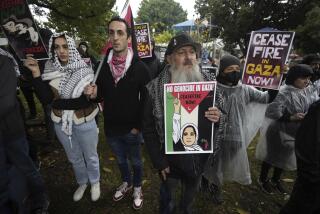Artist Uses Historic Year to Commemorate Sephardic Jews’ Expulsion : Columbus: Raphael Abecassis recount events in Spain, where a century of persecution culminated in forced conversion, exile or death in 1492.
FAIRFAX — Israeli artist Raphael Abecassis remembers how he felt when he began to study the horrendous events that led up to the expulsion of the Jews from Spain in 1492.
“When I first read about the subject, I wanted to paint everything in black,” said Abecassis, who was in Los Angeles recently for the opening of an expulsion-related show at the Jewish Federation Building.
Like Latinos and American Indians, Sephardic Jews are using the occasion of the quincentenary of Columbus’ epic voyage to give the world their own take on the world-changing events of 500 years ago.
For the Jews of Spain, 1492 was a tragic year. After a century of persecution, 1492 saw the abrupt and brutal extermination of a Jewish presence in Spain, once the flourishing center of Jewish culture. Even as King Ferdinand and Queen Isabella were blessing Columbus, they were condemning their country’s Jews, forcing them to choose among conversion, exile or death.
According to historians, property taken from the banished Jews financed Columbus’ second voyage.
Historians disagree as to the number of Jews who fled Spain, with estimates ranging from 100,000 to more than 400,000. The expulsion caused the Jews to disperse throughout the world, with many settling in the Ottoman Empire and in North Africa. The exiled and their descendants are known as the Sephardim, derived from Sepharad, the Hebrew word for Spain.
At the request of the Israeli government, Abecassis created the official poster for the quincentenary of the expulsion. He chose to translate the dark events of 1492 into a bright mosaic of Jewish symbols, including the domes of Jerusalem, the traditional focus of Jewish hopes.
Abecassis, 39, was born in Marrakech, Morocco, and lives in Netanya, Israel. Through an interpreter, he said the anniversary of the expulsion had given Israeli Sephardim an opportunity to bring their history and contributions to the attention of a nation that has been dominated by Jews of mid-European ancestry, or Ashkenazim.
There is no buzz on the streets of Tel Aviv about the anniversary, he said, but it has galvanized many Sephardic groups, particularly those who speak Ladino, the blend of Hebrew and Spanish that the banished took with them into exile.
The events of 1492 and its aftermath are being taught in Israeli schools, he said. He noted that in Israel the hundreds of thousands of Jews who were forcibly converted in Spain and Portugal starting in the 14th Century are known as Anusim, or the coerced.
Abecassis’ work is strongly influenced by traditional Jewish calligraphy (he is skilled enough to write Torah scrolls) and by the non-representational art of the Middle East. He said he chose to make his poster and his many paintings on 1492 as colorful as possible because he wanted to lure viewers into looking long and closely at them.
His paintings on the theme (more than 20 are on view at the Jewish Federation Building) include images of Inquisition and mob violence against the Jews, two-headed figures who represent the culturally conflicted New Christians or Anusim, and images associated with Jewish mysticism such as the dove. Abecassis said the country that once seemed a welcome refuge to Jews fleeing Roman persecution eventually became a place of pain and suffering in its own right.
The work by Abecassis is part of an exhibit called “Echoes of Sepharad,” which continues in the Pauline Hirsh Gallery of the federation through April 10. It includes Sephardic ritual objects and photographic exhibits on the Jews of Morocco, Greece and Turkey. The exhibit is sponsored by the gallery and Project Rediscovery: 1492-1992, of the Sephardic Hebrew Academy.
Rabbi Baruch Kupfer, executive director of the Sephardic Hebrew Academy, said the purpose of Project Rediscovery “is to create an interest and awareness of the Sephardic aspect of Jewish culture and to educate people about the Sephardic contribution to Jewish tradition and culture.”
He estimated that 50,000 to 100,000 Sephardic Jews live in greater Los Angeles.
“There’s not much to celebrate,” Kupfer said of the events of 1492. He said, however, that the anniversary is an appropriate time to remember the fact that most of the Jews driven from Spain were afforded refuge by Sultan Beyazit II, ruler of the Ottoman Empire. Jews lived relatively unmolested in the Ottoman Empire and later in Turkey.
Last week, the academy honored Arif Mardin, a record industry executive and a leader of the Turkish-American community, with its Shofar of Peace award at a banquet at which Sephardic and Ashkenazi leaders were also cited. Mardin is a Muslim.
The Jewish Federation Building is at 6505 Wilshire Blvd. The Hirsh gallery is open weekdays from 10 a.m. to 6 p.m., except Friday, when it closes at 3 p.m. For further information, call (213) 852-1234, Ext. 2955 or 2117.
More to Read
Sign up for Essential California
The most important California stories and recommendations in your inbox every morning.
You may occasionally receive promotional content from the Los Angeles Times.










